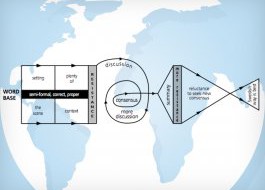
Want to provide better feedback, introduce people, or master small talk? Try this technique.
I asked my students and consulting clients in an informal poll, and the results surprised me. My "subjects" were engaging in up to five different types of communication actions in this short time period — and I wasn't even counting texts or emails.
From answering questions to initiating small talk, from introducing people to each other to providing feedback, we all find ourselves needing to adeptly manage different types of communication.
This nimbleness, when paired with social expectations of appropriateness and efficiency in our communication, can be quite daunting to even the most experienced.
The key to managing these different types of communication is to leverage structures. Communication structures serve as scaffolding for our messages. They allow us easy starting points, transitions, and clear endings. They help us to be concise and relevant. Finally, research evidence exists that structured information is more easily processed and remembered by our audiences.
While many structures exist, I have found one structure reigns supreme in applicability and simplicity: The "What? So what? Now what?" structure must be part of your communication toolkit.
This structure is logical and clear. Let me break it down:
What?
First, define or describe your key ideas or arguments. Do so in a clear, concise manner devoid of jargon and flourishes. Ask yourself, "What are the critical few bits of information that I need to convey to maximize fidelity?"
So what?
This second part has you focusing on the relevance of your ideas or arguments to your audience. You must be sure to take your audience's perspective into account. Remember, if you are to maximize fidelity and remembering, it's less about what you want to say and more about what your audience needs to hear. Say to yourself: "The bottom line for you (my audience) is …"
Now what?
Finally, your last part highlights the thoughts, feelings, and actions you wish your audience to hold or enact. Be clear and direct in how you phrase these so as to reduce ambiguity. Be cognizant of the tone you use to convey this information. Your tone (e.g., sense of urgency, confidence, excitement, etc.) directly impacts your audience's perception of both you and your message.
At the highest level, the "What? So what? Now what?" structure affords you cognitive bandwidth because it provides you with how you intend to convey your messages so you can focus on the specific details of what you wish to say. With practice, you can learn to manage the barrage of communication situations you face by deploying this Swiss Army Knife of communication structures.
How does this structure look in practice? Here are some ways you can employ this technique.
Q&A
Questions are a great opportunity to deploy this structure. For example, imagine a job interview where you are asked: "Why are you qualified for this job?"
What? I have over 12 years of experience incustomer-facing work addressing challenges such as migrating tonew systems and implementing new processes. So what? These previous experiences will helpme provide your customers with high-quality results, while alsoassisting you to streamline your deployment process. Now what? I'm happy to have you discuss myqualifications with some of my former clients.Feedback
I often coach clients who need to provide constructive feedback to leverage this structure. For example, you have a colleague who failed to complete his report on time.
What? I've noticed that your report was notsubmitted within our agreed upon timeframe. So what? This puts us at a disadvantage forpracticing our pitch and might jeopardize our client meeting. Now what? I need for you to complete thisreport by tomorrow morning. Please let me know what I can do toassist you.Introducing Something or Someone
Introductions can often ramble and confuse. Using this structure can help you be clear and set expectations for what is to come.
Introducing Something
What? I am excited to introduce the latestversion of our product. In this release we've added manyusability enhancements and improved our speed. So what? Now our clients can more easilycomplete their tasks and save time and money. Now what? When you leave this conferencesession, please install it today.Introducing Someone
What? I am honored to introduce Dr. JonasSmith, who is here to discuss her insights into game theory. So what? Her work has changed the way manypeople go about making daily decisions. I am certain you willthink differently when you leave here tonight. Now what? Without further ado, join me inwelcoming Dr. Smith.Making Small Talk
Many of us struggle to engage in small talk, especially with people we don't know well. This structure can help you to engage and sustain initial conversations. Simply use the three questions to get your targets to express themselves.
What? What do you know about the latestattempt to reduce energy consumption? So what? Why do you think it is so importantto reduce energy? Now what? What can I do to help reduce myenergy use?Read the original article on Stanford Graduate School of Business. Copyright 2017.




